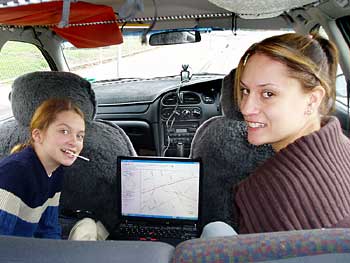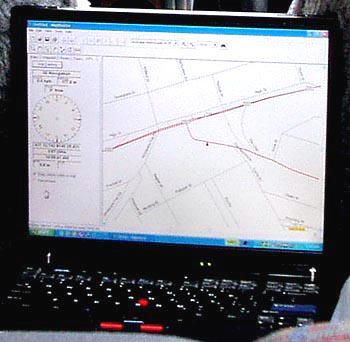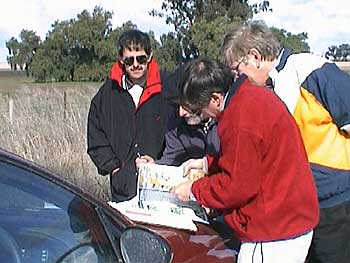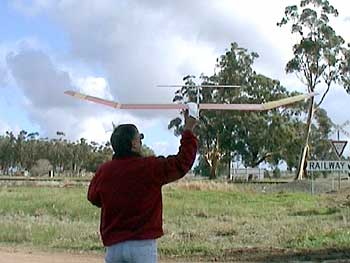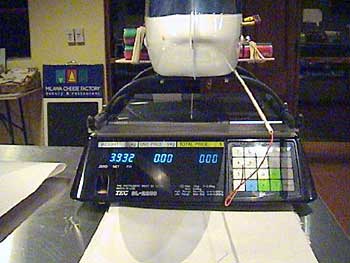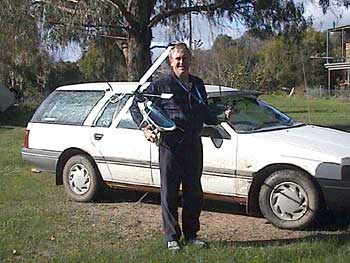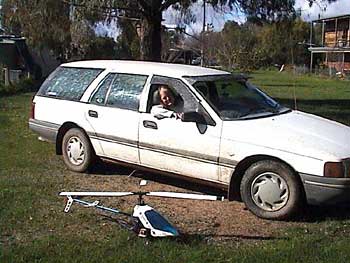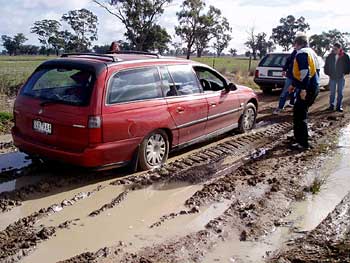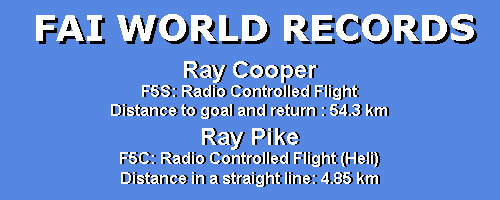
On Sunday 4 July, 2004, two Australians, Ray Cooper and Ray Pike set new world distance records for Electric Powered, Fixed and Rotary Wing Model Aircraft. Location of flights : Tungamah, Northern Victoria - Australia Record #1 : RAY COOPER go to RAY PIKE
Category: F5 : Radio Controlled Flight
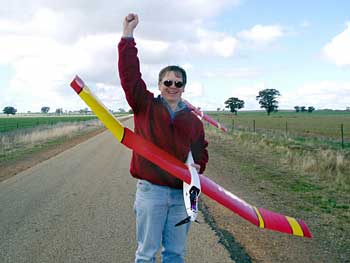
Ray Cooper at the end of the record breaking flight It was decided to travel to the Wangaratta area to do some reconnaissance of the roads and if the weather permitted then an attempt would be tried. Finding a suitable road proved to be more difficult than expected and in fact it took about 4 hours to find a road. Most of the roads had large amounts of trees, which made visibility a problem. Getting bogged did not help! All of this travelling and searching was done on the Sunday morning (04/07/2004). By the end of the day, a total of 350 km had been travelled.
Our group consisted of:
Ray Cooper, Pilot Ray Pike, FAI Observer Anne Cooper, Driver Emma Cooper, video operator
Car 2
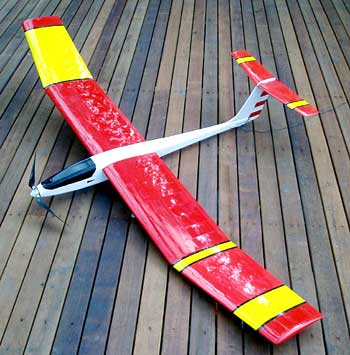
Ray Cooper's "Little Bird"
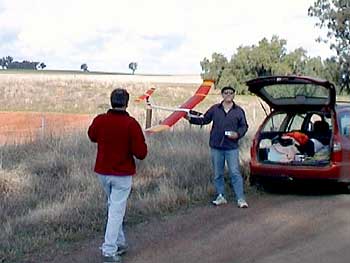 Range test - Bob Hickman assists Ray Cooper Family ready to navigate - Beth and Emma ready to go
Navigation screen detail Setting the Goal, the Turn point "B" prior to launch. L-R : Neil Hardiman, Bob Hickman, Ray Cooper and Ray Pike Launch - Ray Cooper starts the journey
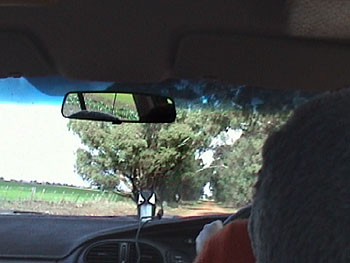 One of several tree obstacles encountered
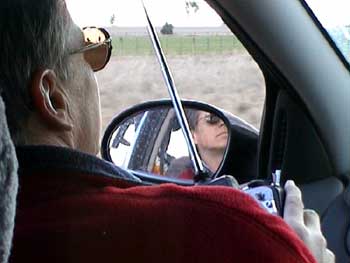 Without trees to worry about, flying from the car was quite relaxed
During the flight some large thermals were encountered and this enabled the throttle to be reduced to conserve battery power. Sink patches were not as obvious. After 1 hour and 22 minutes the model was landed about 50 metres from the launch point, with smiles all round!
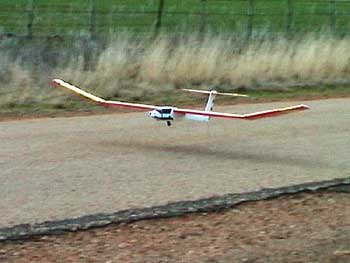 Landing - the journey ends
Ray Pike once again did a fantastic job in looking after the official side of the event. And last but not least, thank you to my family for putting up with another record attempt. All had a great fun weekend. Record #2 : RAY PIKE
Category: F5: Radio Controlled Flight
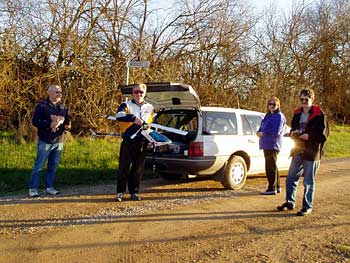 Ray Pike starts out to set a new FAI record L-R: Bob Hickman, Ray, Ray's wife Erica and Neil Hardiman
The radio system used was a Multiplex 4000 transmitter fitted with Sanyo 3300 NiMH cells giving a duration in excess of 9 hours. I used a Schulze Alpha 835w and the servos Multiplex Royal digitals. I used 4 x Sanyo CP 1300 cells for the receiver and the gyro was a Robbe 3D #8065 and the total weight of the model, ready to fly was 3.932Kg.
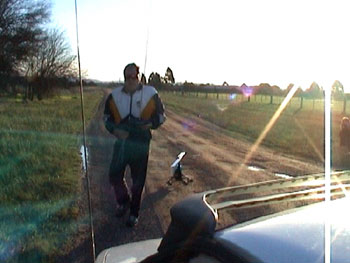 video frame grab just before launch
A flight was made about 1 km north east of the Township of Oxley along a dirt road that had a power line and some high trees running along the right side and low trees on the left. The model was successfully flown along in front of the car at a height of approximately 3 meters. The model was kept about 20 to 30 meters either in front of the car or slightly to the left side. The pilot was in the front left passenger seat. The model was prepared; radio control system turned on and tested and the motor was armed. The model was placed on the road in front of the car and the driver, pilot and observers were seated in the car. The motor was started and the helicopter almost immediately put into slow forward flight. The car followed along with frequent instructions from the pilot regarding the desired speed.
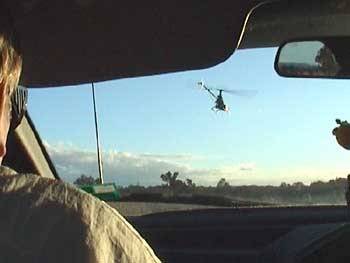 video frame grab of heli in flight
There was also about a 5-10 knot cross wind from the right (North) that made it more difficult to maintain constant height and heading. This was particularly so as the model flew into the wind shadow of the large trees along the right side of the road. The flight proceeded without incident and the model was landed at the nominated landing area, 2.1km from the takeoff spot. Flight time for the distance was 3min 47sec. As there was no current record, this was a new World record!
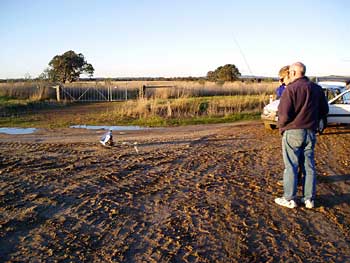 Ray Pike touches down after his record breaking flight
This was proving quite difficult, especially finding easily identified take off and landing areas, like cross roads on the 1:100,000 map. Another problem was that the wind was now increasing in strength. When a suitable road was found, it was decided to have a second attempt on the straight-line record, this time flying down wind. The car was placed on the right side of the road pointing towards our goal. The model's radio control system was switched on and the motor armed. The model was placed on the road facing into the wind - the opposite direction to the landing point and pilot and crew got into the car. The helicopter motor was started and the model was raised into a brief hover before performing a 180 degree turn away from the car and down wind towards the landing point. The ground speed for this attempt was much higher than the attempt on the previous day. At times the car speedometer registered 80kph. The flight was generally uneventful, the helicopter being slowed down when the train line was crossed (about 1 meter above the surrounding ground) and the short 90o right and then 90o left turn was performed along the track. After about 5 minutes we reached the landing location and I hovered the helicopter over a paddock on the left side of the car. After a brief period, I asked that the car door be opened for me so that I might attempt to land the helicopter on the road in front of the car. After I got out of the car, I brought the model back over the road and landed it. We were about 20-30 meters from the cross roads that were the nominated landing place. It was not easy to land exactly on the nominated spot, as there were high trees over hanging this point. This was not a problem as it is permissible to land up to 500 meters from the designated landing place and still make claim to the record. Later in the day, an attempt was made to complete a goal and return attempt back at the Oxley location. Unfortunately, the location of the turn around point had not been carefully enough considered and it became too difficult to fly the helicopter from the car while turning the car around. Apart from the visibility problems as the car turned, there were obstacles on both edges of the road. The model was safely landed beside the road and the attempt for the goal and return was cancelled.
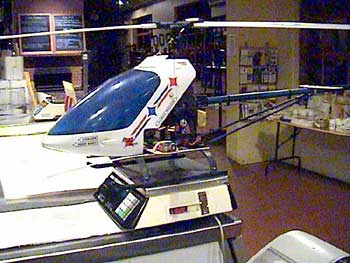 and the weigh in "weight is right" 3.932 Kg Ray Pike and the 'Sonic' Erica Pike and the 'Sonic'
Notes : The record attempts were made from cars driving on semi-deserted country back roads with the pilots located in the front passenger seat tracking the aircraft.
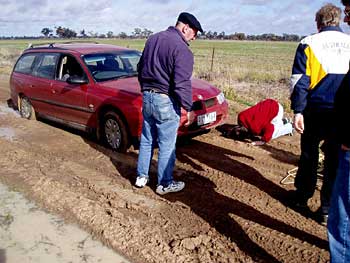 ...and then there was THE MUD ...and even more MUD
MAAA and FAI 'observers' also travelled with each pilot and driver monitoring the two record attempts. They were : Bob Hickman, Neil Hardiman, Erica Pike and Ray Pike and Ray Cooper on hand for each other's attempt. The drivers and support crew for both record attempts were: Anne, Emma and Bethany Cooper
|
© Copyright 1999-2004 CTIE - All Rights Reserved - Caution |
